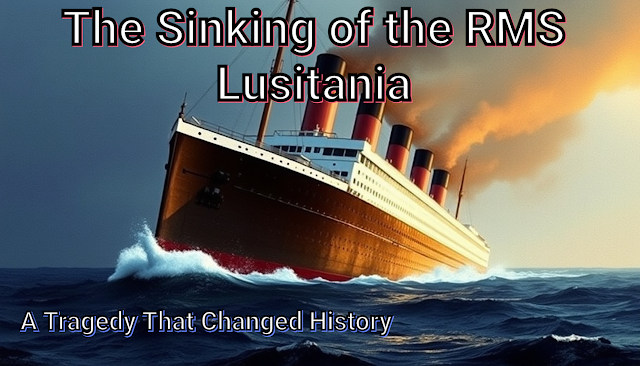The Sinking of the RMS Lusitania: A Tragedy That Changed History
coast of Ireland, sinking in just 18 minutes. This disaster claimed the lives of 1,198 passengers and crew members, including many American citizens, and became a pivotal moment in World War I. The sinking of the Lusitania shocked the world, contributing to a shift in public opinion in the United States and hastening its eventual entry into the war.
1. The RMS Lusitania: A Marvel of Its Time
The RMS Lusitania, launched in 1906, was one of the fastest and most luxurious ships of its era. Operated by the Cunard Line, the Lusitania was built to compete with German liners that dominated the Atlantic passenger market at the time. It could carry almost 2,000 passengers and boasted state-of-the-art amenities, including grand dining rooms, lounges, and staterooms designed to cater to wealthy travelers.
The Lusitania was also seen as a symbol of British naval strength. With its impressive speed, the ship could easily outrun most German U-boats, making it seem nearly invincible. However, as World War I escalated, transatlantic travel became increasingly perilous due to the German policy of unrestricted submarine warfare.
2. The Lead-Up to the Tragedy
In early 1915, Germany declared the waters around the British Isles a war zone. Any ships, including civilian ones, sailing through the area risked being attacked by German submarines (U-boats). The German government issued warnings in American newspapers, cautioning passengers about the dangers of traveling on British ships.
Despite these warnings, the Lusitania left New York on May 1, 1915, bound for Liverpool with 1,962 passengers and crew aboard. Many of the passengers, including families, businessmen, and American citizens, did not believe that a civilian ship would be targeted, especially one as famous as the Lusitania. They trusted that the ship's speed and the fact that it was carrying civilians would protect it from attack.
3. The Attack
On the afternoon of May 7, 1915, the Lusitania was nearing the coast of Ireland, within sight of the Old Head of Kinsale. Without warning, it was struck by a torpedo fired by the German submarine U-20, commanded by Kapitänleutnant Walther Schwieger. The torpedo hit the starboard side of the Lusitania, causing a massive explosion.
Within minutes, the ship began to list heavily to one side. Panic spread among the passengers as lifeboats were hastily lowered into the water, many of them unevenly or without enough people to safely manage them. To make matters worse, the ship was sinking rapidly—faster than anyone had anticipated. Within just 18 minutes, the Lusitania disappeared beneath the waves, leaving hundreds of passengers struggling in the icy waters of the Atlantic.
4. The Aftermath: International Outrage
The loss of life was devastating. Of the 1,962 people aboard the Lusitania, 1,198 perished, including 128 American citizens. News of the sinking spread quickly, sparking outrage in both Britain and the United States. Many people, particularly in the U.S., viewed the attack as an atrocity against innocent civilians, and it became a rallying cry for those advocating for U.S. involvement in the war.
The German government defended the attack, claiming that the Lusitania had been carrying military supplies for Britain, making it a legitimate target. Indeed, it was later confirmed that the Lusitania had been carrying ammunition and war materials in addition to its civilian passengers. However, this did little to lessen the public outcry over the loss of civilian life.
5. The Impact on World War I
The sinking of the Lusitania had profound consequences for the course of World War I. While the U.S. did not immediately enter the war following the tragedy, the incident marked a turning point in American public opinion. Previously, the U.S. had remained neutral, with many Americans supporting a policy of isolationism.
However, the Lusitania disaster, combined with Germany’s continued use of unrestricted submarine warfare, pushed the U.S. closer to joining the war on the side of the Allies. In 1917, after repeated provocations, including the Zimmermann Telegram and renewed submarine attacks, the United States officially declared war on Germany, fundamentally altering the course of the conflict.
6. Legacy and Remembrance
The sinking of the Lusitania remains one of the most infamous events of World War I. In the years following the tragedy, investigations were conducted into the ship’s sinking, but the exact cause of the rapid second explosion that hastened the ship’s demise has been the subject of debate. Some believe it was caused by the munitions aboard, while others suggest that the torpedo hit a steam line or coal dust in the ship's bunkers.
Memorials to the victims of the Lusitania can be found in both Britain and Ireland, and the shipwreck remains at the bottom of the ocean, off the coast of Ireland. Over a century later, the story of the Lusitania serves as a reminder of the fragility of life during wartime and the profound human cost of conflict.
The sinking of the RMS Lusitania was not just a maritime disaster; it was a pivotal moment in the history of World War I. The tragedy highlighted the dangers of unrestricted submarine warfare and played a significant role in shaping international relations at the time. It remains a haunting chapter in history, symbolizing the destructive power of war and the devastating loss of civilian life.

